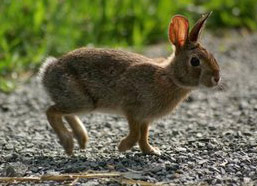NPR produced a nice piece recently on New England cottontail restoration efforts in Cape Cod, Massachusetts. You can listen and/or read a transcript here.
For those not familiar with this critter, the NE cottontail’s story is a quirky one. Used to be that this was our New England rabbit (it was your rabbit in New York, too). But by the latter half of the 20th century, it was in decline. The reason given was “habitat destruction,” which in urban circles is often taken to mean that profit-minded humans cut down the forest. But, in fact, the trees are to blame here, or, I suppose, humans are to blame for not clearcutting them more intensely. The NE cottontail thrives in brushy, thick cover but not so well elsewhere. So as the forest came back, the rabbits declined.
Where we can justifiably point the finger at ourselves is in the fact that we humans introduced the Eastern cottontail rabbit to the region, which further compounded the NE cottontail’s problems (you can decide for yourself whether this was a bad thing). In a remarkably short time the new bunny took over. In Vermont, for example, Eastern cottontails were first reported in the 1960s – they’d hopped up from the Hudson valley – and by 1971 the NE cottontail was suspected to have been extirpated from the state. The Easterns, which look nearly identical to the New Englands, are slightly larger and have a wider range of vision, which allow them to outcompete the smaller, native rabbits.
Where things get complex is when we consider what to do about the remaining pockets of New England cottontails that exist in the region. Today you can find them in very small numbers in parts of southern New Hampshire and Maine, eastern Connecticut, Rhode Island, New York, and on Cape Cod. Some state wildlife management folks I’ve spoken to about the rabbit speak of a strange dance in which they’re trying to protect the species while at the same time trying to fend off a federal endangered species listing, which, despite its good intention, can be a bad thing. Yes, a federal listing would mean federal money, but the strings that come with it – the hunting ban on all rabbits (remember, it’s almost impossible to tell the two species apart at a glance), the effects on municipal planning, the politically mandated clearcuts – could be a nightmare.
So what do you think? Would a federal listing be good or a bad? Is it immoral to suggest that if the introduced eastern cottontails look the same, act the same, and work better in our current landscape, that we should just let the native ones go extinct? Have you been involved in NE cottontail restoration work, and if so, what are some of the struggles or successes you’ve had?
For my part, I see this as a great opportunity for landowners to do something to help a species that’s really in trouble. I think it’s fair to be wary of government intervention in this matter, but individual landowners are unencumbered by bureaucratic strings. If you live in an area with a refugee New England cottontail population, consider an early-successional patch cut to help them out.
More information can be found at: http://extension.unh.edu/resources/files/Resource001135_Rep1417.pdf
----------------------------------------------------------------------------------------------------------------------------------------------------
New England Cottontail Hops Off Endangered List
SEP 17, 2015 04:30 PM ET //












No comments:
Post a Comment